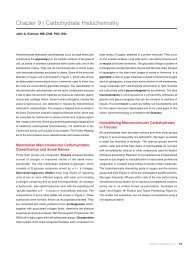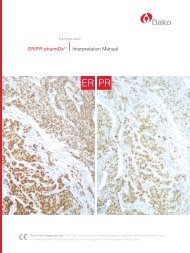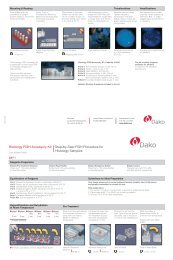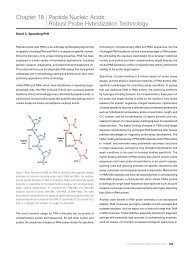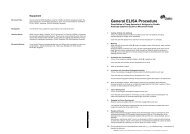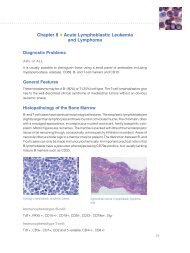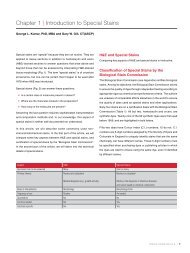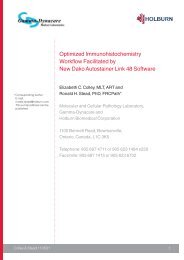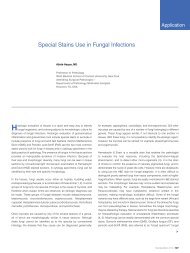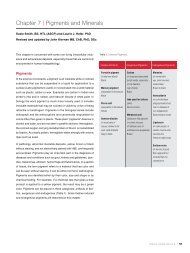Chapter 15 | Multi-Staining Immunohistochemistry - Dako
Chapter 15 | Multi-Staining Immunohistochemistry - Dako
Chapter 15 | Multi-Staining Immunohistochemistry - Dako
You also want an ePaper? Increase the reach of your titles
YUMPU automatically turns print PDFs into web optimized ePapers that Google loves.
<strong>Multi</strong>-<strong>Staining</strong> <strong>Immunohistochemistry</strong><br />
Pre-treatment<br />
<strong>Multi</strong>ple staining, like single staining, can be performed on both<br />
formalin-fixed, paraffin-embedded tissue sections, frozen sections,<br />
cell smears and cytospin preparations. <strong>Multi</strong>ple staining is constrained<br />
by the fact that it may not be possible to find one tissue pre-treatment<br />
protocol that is optimal for all targets. often protocols optimized for<br />
individual stainings differ from one target to the other, e.g. different<br />
target retrieval methods may be used. In this case, it may be necessary<br />
to determine a method that allows all targets to be stained, although<br />
the method may be sub-optimal for some targets.<br />
In cases where targets of different abundance are to be stained, a<br />
method must be selected to best balance the signals. Combining<br />
ISH and IHC on one slide is particularly challenging because targets<br />
require very different pre-treatment protocols. Since ISH processes<br />
such as dna denaturing are not compatible with the presence of the<br />
antibodies for IHC, the ISH protocol is normally performed first.<br />
<strong>Multi</strong>-<strong>Staining</strong> Method Selection<br />
to ensure success, IHC staining must be carefully planned. this is<br />
even more important with multi–staining. If primary antibodies, both<br />
directly-labeled and unlabeled and from different host-species, are<br />
commercially available, there are several different staining methods<br />
that one can choose. However, very often the choice may be limited<br />
by the reagents available (3). Care must be taken to avoid crossreactivity<br />
between reagents. a flow chart or similar aid might prove<br />
useful in selecting the best method.<br />
In general, staining methods can be divided into the following classes:<br />
Sequential staining: By this method, one staining procedure<br />
succeeds another. For example, the first primary antibody is applied<br />
to the tissue section followed by a labeled detection system such as<br />
streptavidin-biotin horseradish peroxidase (HRP), with a chromogen<br />
such as daB. the second primary antibody is applied only after the<br />
excess daB is rinsed off, followed by labeling with a streptavidinbiotin<br />
alkaline phosphatase (aP) detection system and a colored<br />
chromogen. the biggest advantage of sequential staining is that by<br />
this procedure problems related to cross-reactivity are avoided.<br />
104 | IHC StaInIng MetHodS, FIFtH edItIon<br />
a sequential staining is shown in Figure 1. Here, the primary and<br />
secondary antibodies from the first staining were eluted before the<br />
staining of the next target was performed. the disadvantages of<br />
sequential staining are: the method cannot be used for co-localized<br />
targets, the technique often leads to a long staining protocol<br />
and carries an inherent risk of incorrect double staining due to<br />
insufficient elution of one set of reagents before application of the<br />
next reagent.<br />
Figure 1. Sequential double staining method performed with the EnVision TM G⎜2<br />
Doublestain Kit using polyclonal anti-kappa light chains (red) and polyclonal<br />
anti-lambda light chains (brown) as primary antibodies. Formalin-fixed, paraffinembedded<br />
tissue sections from tonsils.<br />
elution may become an issue with some high-affinity primary<br />
antibodies as these may remain at their binding site, leading to<br />
spurious double stained structures. elution also risks denaturing<br />
epitopes of antigens to be visualized subsequently. Furthermore, for<br />
some chromogens there is a risk that the first chromogen (daB in<br />
particular) may shield other targets. this technique is, therefore, not<br />
recommended for evaluation of mixed colors at sites of co-localization,<br />
because not all reaction products are capable of surviving the rigorous<br />
washing required to remove the antibodies. to avoid such problems<br />
and blurry staining results, it is recommended to use the most “robust”<br />
dyes such as daB, Fast Red, aeC and X-gal first followed by other<br />
less “robust” dyes.




